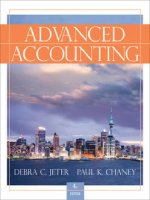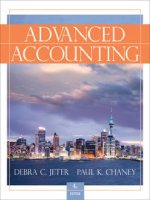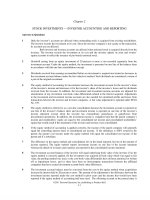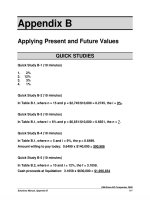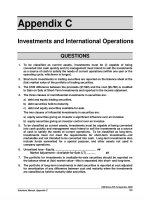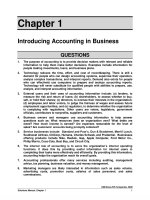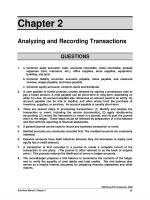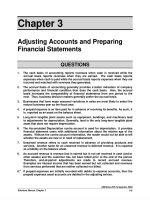Solution manual financial accounting 4e by wild chapter02
Bạn đang xem bản rút gọn của tài liệu. Xem và tải ngay bản đầy đủ của tài liệu tại đây (412 KB, 0 trang )
To download more slides, ebook, solutions and test bank, visit
Chapter 2
Analyzing and Recording Transactions
QUESTIONS
1.
a. Common asset accounts: cash, accounts receivable, notes receivable, prepaid
expenses (rent, insurance, etc.), office supplies, store supplies, equipment,
building, and land.
b. Common liability accounts: accounts payable, notes payable, and unearned
revenue, wages payable, and taxes payable.
c. Common equity accounts: common stock and dividends.
2.
A note payable is formal promise, usually denoted by signing a promissory note to
pay a future amount. A note payable can be short-term or long-term, depending on
when it is due. An account payable also references an amount owed to an entity. An
account payable can be oral or implied, and often arises from the purchase of
inventory, supplies, or services. An account payable is usually short-term.
3.
There are several steps in processing transactions: (1) Identify and analyze the
transaction or event, including the source document(s), (2) apply double-entry
accounting, (3) record the transaction or event in a journal, and (4) post the journal
entry to the ledger. These steps would be followed by preparation of a trial balance
and then with the reporting of financial statements.
4.
A general journal can be used to record any business transaction or event.
5.
Debited accounts are commonly recorded first. The credited accounts are commonly
indented.
6.
Expense accounts have debit balances because they are decreases to equity (and
equity has a credit balance).
7.
A transaction is first recorded in a journal to create a complete record of the
transaction in one place. (The journal is often referred to as the book of original
entry.) This process reduces the likelihood of errors in ledger accounts.
8.
The recordkeeper prepares a trial balance to summarize the contents of the ledger
and to verify the equality of total debits and total credits. The trial balance also
serves as a helpful internal document for preparing financial statements and other
reports.
©McGraw-Hill Companies, 2008
Solutions Manual, Chapter 2
55
To download more slides, ebook, solutions and test bank, visit
9. The error should be corrected with a separate (subsequent) correcting entry. The
entry’s explanation should describe why the correction is necessary.
10. The four financial statements are: income statement, balance sheet, statement of
retained earnings, and statement of cash flows.
11. The income statement lists the types and amounts of revenues and expenses, and
reports whether the business earned a net income (also called profit or earnings) or
a net loss.
12. An income statement user must know what time period is covered to judge whether
the company’s performance is satisfactory. For example, a statement user would
not be able to assess whether the amounts of revenue and net income are
satisfactory without knowing whether they were earned over a week, a month, a
quarter, or a year.
13. The balance sheet provides information that helps users understand a company’s
financial position at a point in time. Accordingly, it is often called the statement of
financial position. The balance sheet lists the types and dollar amounts of assets,
liabilities, and equity of the business.
14. (a) Assets are probable future economic benefits obtained or controlled by a specific
entity as a result of past transactions or events. (b) Liabilities are probable future
sacrifices of economic benefits arising from present obligations of a particular entity
to transfer assets or provide services to other entities in the future as a result of past
transactions or events. (c) Equity is the residual interest in the assets of an entity
that remains after deducting its liabilities. (d) Net assets refer to equity.
15. The balance sheet is sometimes referred to as the statement of financial position.
16. Debit balance accounts on the Best Buy balance sheet include: Cash and cash
equivalents; Short-term investments; Receivables; Merchandise inventories; Other
current assets;
Land and buildings; Leasehold improvements; Fixtures and
equipment; Property under master and capital lease; Goodwill, Tradename; LongTerm Investments; Other Assets
Credit balance accounts on the Best Buy balance sheet include: Accounts payable;
Unredeemed gift card liabilities; Accrued compensation and related expenses;
Accrued liabilities; Accrued income taxes; Current portion of long-term debt; LongTerm Liabilities; Long-Term Debt; Preferred Stock; Common Stock; Additional paidin capital; Retained earnings; Accumulated other comprehensive income.
17. Assets with receivable in their account title are Accounts receivable, net of
allowance for doubtful accounts of $120 and $547 [in thousands], and Retained
interests in securitized receivables. The liability with payable in its account title is
Accounts payable.
18. Apple’s revenue account is titled ―Net Sales.‖
©McGraw-Hill Companies, 2008
56
Financial Accounting, 4th Edition
To download more slides, ebook, solutions and test bank, visit
QUICK STUDIES
Quick Study 2-1 (5 minutes)
The likely source documents include:
a. Sales ticket
d. Telephone bill
e. Invoice from supplier
i.
Bank statement
Quick Study 2-2 (10 minutes)
a.
b.
c.
d.
e.
f.
g.
h.
i.
E
B
B
B
I
B
B
B
I
Statement of retained earnings
Balance sheet
Balance sheet
Balance sheet
Income statement
Balance sheet
Balance sheet
Balance sheet
Income statement
Quick Study 2-3 (10 minutes)
a.
b.
c.
d.
Debit
Debit
Credit
Credit
e.
f.
g.
h.
Debit
Credit
Credit
Debit
i.
j.
k.
l.
Credit
Debit
Debit
Credit
Debit
Credit
Credit
Credit
i.
j.
Credit
Debit
Quick Study 2-4 (10 minutes)
a.
b.
c.
d.
Debit
Credit
Debit
Credit
e.
f.
g.
h.
©McGraw-Hill Companies, 2008
Solutions Manual, Chapter 2
57
To download more slides, ebook, solutions and test bank, visit
Quick Study 2-5 (10 minutes)
a.
b.
c.
Debit
Debit
Credit
d.
e.
f.
Debit
Debit
Debit
g.
h.
i.
Credit
Debit
Credit
Quick Study 2-6 (15 minutes)
Jan.13 Cash ..........................................................................
Equipment ...............................................................
Common Stock................................................
70,000
30,000
100,000
Owner invests cash and equipment.
21 Office Supplies ........................................................
Accounts Payable ...........................................
280
280
Purchased office supplies on credit.
29 Cash ..........................................................................
Landscaping Services Revenue ....................
7,800
7,800
Received cash for landscaping services.
30 Cash ..........................................................................
Unearned Landscaping Services Revenue ..
1,000
1,000
Received cash in advance for landscaping services.
Quick Study 2-7 (10 minutes)
The correct answer is a.
Explanation: If a $2,250 debit to Rent Expense is incorrectly posted as a
credit, the effect is to understate the Rent Expense debit balance by $4,500.
This causes the Debit column total on the trial balance to be $4,500 less
than the Credit column total.
Quick Study 2-8 (10 minutes)
a.
b.
c.
d.
I
B
B
I
e.
f.
g.
h.
B
B
B
I
i.
j.
E
B
©McGraw-Hill Companies, 2008
58
Financial Accounting, 4th Edition
To download more slides, ebook, solutions and test bank, visit
EXERCISES
Exercise 2-1 (15 minutes)
a.
b.
c.
d.
e.
f.
g.
h.
i.
j.
k.
l.
Account
Accounts Payable ......................
Postage Expense .......................
Prepaid Insurance ......................
Land ............................................
Common Stock...........................
Accounts Receivable .................
Dividends ....................................
Cash ............................................
Equipment ..................................
Fees Earned................................
Wages Expense..........................
Unearned Revenue
Type of
Account
liability
expense
asset
asset
equity
asset
equity
asset
asset
revenue
expense
liability
Increase
(Dr. or Cr.)
credit
debit
debit
debit
credit
debit
debit
debit
debit
credit
debit
credit
Normal
Balance
credit
debit
debit
debit
credit
debit
debit
debit
debit
credit
debit
credit
Exercise 2-2 (15 minutes)
a.
Beginning cash balance (debit) ......................................................
$
?
Cash received in October (debits) ................................................. 102,500
Cash disbursed in October (credits) .............................................. (103,150)
Ending cash balance (debit) ........................................................... $ 18,600
Beginning cash balance (debit) ...................................................... $ 19,250
b.
Beginning accounts receivable (debit) .......................................... $102,500
Sales on account in October (debits) ............................................
?
Collections on account in October (credits) ................................. (102,890)
Ending accounts receivable (debit) ............................................... $ 89,000
Sales on account in October (debits) ............................................ $ 89,390
c.
Beginning accounts payable (credit) ............................................. $152,000
Purchases on account in October (credits) .................................. 281,000
Payments on accounts in October (debits) ...................................
(
?)
Ending accounts payable (credit) .................................................. $132,500
Payments on accounts in October (debits) ................................... $300,500
©McGraw-Hill Companies, 2008
Solutions Manual, Chapter 2
59
To download more slides, ebook, solutions and test bank, visit
Exercise 2-3 (15 minutes)
The company would make the following entry (not required for answer):
Cash ..................................................................
10,000
Computer Equipment ......................................
80,000
Note Payable ..............................................
28,000
Services Revenue ......................................
62,000
Accepted cash, equipment and note for services.
Thus, of the a through e items listed, the following effects should be included:
a. $28,000 increase in a liability account.
b. $10,000 increase in the Cash account.
e. $62,000 increase in a revenue account.
Explanation: This transaction reflects $62,000 in revenue, which is the
value of the service provided. Payment is received in the form of a $10,000
increase in cash, an $80,000 increase in computer equipment, and a
$28,000 increase in its liabilities. The net value received by the company is
$62,000.
Exercise 2-4 (25 minutes)
Aug. 1 Cash ..................................................................
Photography Equipment .................................
Common Stock ..........................................
6,500
33,500
40,000
Owner investment in business.
2 Prepaid Insurance ............................................
Cash ............................................................
2,100
2,100
Acquired 2 years of insurance coverage.
5 Office Supplies .................................................
Cash ............................................................
880
880
Purchased office supplies.
20 Cash ..................................................................
Photography Fees Earned ........................
3,331
3,331
Collected photography fees.
31 Utilities Expense ..............................................
Cash ............................................................
675
675
Paid for August utilities.
©McGraw-Hill Companies, 2008
60
Financial Accounting, 4th Edition
To download more slides, ebook, solutions and test bank, visit
Exercise 2-5 (30 minutes)
Aug. 1
20
Balance
Cash
6,500
Aug. 2
3,331
5
31
6,176
Aug. 5
Office Supplies
880
Aug. 2
Prepaid Insurance
2,100
2,100
880
675
Photography Equipment
Aug. 1
33,500
Common Stock
Aug. 1
40,000
Photography Fees Earned
Aug. 20
3,331
Aug. 31
Utilities Expense
675
POSE-FOR-PICS
Trial Balance
August 31
Debit
Credit
Cash ..........................................................................................
$ 6,176
Office supplies ......................................................................... 880
Prepaid insurance ....................................................................2,100
Photography equipment ..........................................................
33,500
Common stock .........................................................................
$40,000
Photography fees earned ........................................................
3,331
Utilities expense ....................................................................... 675
______
Totals .........................................................................................
$43,331
$43,331
©McGraw-Hill Companies, 2008
Solutions Manual, Chapter 2
61
To download more slides, ebook, solutions and test bank, visit
Exercise 2-6 (30 minutes)
(a)
(d)
(h)
Balance
Cash
13,325
2,000
2,300
(b)
(e)
(g)
(i)
475
6,235
775
800
(e)
9,340
(f)
Balance
Accounts Receivable
3,300
(h)
1,000
(b)
Balance
Office Supplies
475
475
(c)
Balance
Office Equipment
6,235
6,235
2,300
(i)
Balance
Accounts Payable
6,235 (c)
Balance
6,235
0
Common Stock
(a)
Balance
13,325
13,325
Dividends
800
800
Fees Earned
(d)
(f)
Balance
(g)
Balance
2,000
3,300
5,300
Rent Expense
775
775
Exercise 2-7 (15 minutes)
AMENA COMPANY
Trial Balance
May 31, 2008
Debit
Cash .................................................................................................
$ 9,340
Accounts receivable .......................................................................1,000
Office supplies ................................................................................ 475
Office equipment ............................................................................6,235
Accounts payable ...........................................................................
Common Stock ...............................................................................
Dividends ........................................................................................ 800
Fees earned.....................................................................................
Rent expense .................................................................................. 775
Totals ...............................................................................................
$18,625
Credit
$
0
13,325
5,300
______
$18,625
©McGraw-Hill Companies, 2008
62
Financial Accounting, 4th Edition
To download more slides, ebook, solutions and test bank, visit
Exercise 2-8 (20 minutes)
Transactions that created revenues:
b.
Accounts Receivable ..........................................
Services Revenue .........................................
2,300
2,300
Provided services on credit.
c.
Cash .....................................................................
Services Revenue .........................................
875
875
Provided services for cash.
[Note: Revenues are inflows of assets (or decreases in liabilities)
received in exchange for goods or services provided to customers.]
Transactions that did not create revenues along with the reasons are:
a. This transaction brought in cash, but this is an owner investment.
d. This transaction brought in cash, but it created a liability because the
services have not yet been provided to the client.
e. This transaction changed the form of the asset from accounts
receivable to cash. Total assets were not increased (revenue was
recognized when the receivable was originally recorded).
f.
This transaction brought in cash and increased assets, but it also
increased a liability by the same amount (no goods or services were
provided to generate revenue).
©McGraw-Hill Companies, 2008
Solutions Manual, Chapter 2
63
To download more slides, ebook, solutions and test bank, visit
Exercise 2-9 (20 minutes)
Transactions that created expenses:
b.
Salaries Expense.........................................
Cash .......................................................
1,233
1,233
Paid salary of receptionist.
d.
Utilities Expense .........................................
Cash .......................................................
870
870
Paid utilities for the office.
[Note: Expenses are outflows or using up of assets (or the creation of
liabilities) that occur in the process of providing goods or services to
customers.]
Transactions a, c, and e are not expenses for the following reasons:
a. This transaction decreased assets in settlement of a previously
existing liability, and equity did not change. Cash payment does not
mean the same as using up of assets (expense was recorded when the
supplies were used).
c. This transaction involves the purchase of an asset. The form of the
company’s assets changed, but total assets did not change, and the
equity did not decrease.
e. This transaction is a distribution of cash to the owner. Even though
equity decreased, the decrease did not occur in the process of
providing goods or services to customers.
Exercise 2-10 (15 minutes)
ONTECH
Income Statement
For Month Ended October 31
Revenues
Consulting fees earned .........................
Expenses
Salaries expense ...................................
Rent expense .........................................
Telephone expense ...............................
Miscellaneous expenses ......................
Total expenses ......................................
Net income ..................................................
$14,000
$7,000
3,550
760
580
11,890
$ 2,110
©McGraw-Hill Companies, 2008
64
Financial Accounting, 4th Edition
To download more slides, ebook, solutions and test bank, visit
Exercise 2-11 (15 minutes)
ONTECH
Statement of Retained Earnings
For Month Ended October 31
Retained earnings, October 1 ...................
Add: Net income (from Exercise 2-10) ......
Less: Dividends .........................................
Retained earnings, October 31 .................
$
0
2,110
2,110
2,000
$ 110
Exercise 2-12 (15 minutes)
ONTECH
Balance Sheet
October 31
Assets
Cash ............................... $11,360
Accounts receivable .... 14,000
Office supplies ..............
3,250
Office equipment .......... 18,000
Patents .......................... 46,000
Total assets ................... $92,610
*
Liabilities
Accounts payable ................
$ 8,500
Equity
Common stock ....................
Retained earnings ...............
Total liabilities & equity ......
84,000
110*
$92,610
Computation shown in Exercise 2-11.
©McGraw-Hill Companies, 2008
Solutions Manual, Chapter 2
65
To download more slides, ebook, solutions and test bank, visit
Exercise 2-13 (20 minutes)
Assets
a.
Beginning of the year .......... $ 60,000
End of the year ..................... 105,000
Net increase in equity ..........
Net Income ............................
Plus owner investments ......
Less dividends .....................
Change in equity ..................
-
Liabilities
$20,000
36,000
= Equity
= $40,000
= 69,000
$29,000
$
?
0
(0)
$29,000
Therefore, income must equal $29,000.
b.
Net income ................................................................................$
?
Plus owner investments ..........................................................
0
Less dividends ($1,250/mo. x 12 mo.) ....................................(15,000)
Change in equity ......................................................................$29,000
Therefore, net income must equal ($29,000 + $15,000) = $44,000
c.
Net income ................................................................................$
?
Plus owner investment ............................................................ 55,000
Less dividends .........................................................................
(0)
Change in equity ......................................................................$29,000
Therefore, the net loss must equal ($29,000 - $55,000) = $(26,000)
d.
Net income ................................................................................$
?
Plus owner investment ............................................................ 35,000
Less dividends ($1,250/mo. x 12 mo.) ....................................(15,000)
Change in equity ......................................................................$29,000
Therefore, income must equal ($29,000+$15,000-$35,000)= $9,000
©McGraw-Hill Companies, 2008
66
Financial Accounting, 4th Edition
To download more slides, ebook, solutions and test bank, visit
Exercise 2-14 (15 minutes)
(a)
Answers
(b)
$(28,000)
Computations:
Equity, Dec. 31, 2007 ..............
$
0
(c)
$42,000
$
0
(d)
$73,000
$(45,000)
$
$
0
0
Owner's investments .............
110,000
42,000
87,000
210,000
Dividends ................................
(28,000)
(47,000)
(10,000)
(55,000)
Net income (loss) ...................22,000
90,000
(4,000)
(45,000)
Equity, Dec. 31, 2008 ..............
$104,000
$85,000
$73,000
$110,000
Exercise 2-15 (25 minutes)
a. Belle created a new business and invested $6,000 cash, $7,600 of
equipment, and $12,000 in automobiles in exchange for common stock.
b. Paid $4,800 cash in advance for insurance coverage.
c. Paid $900 cash for office supplies.
d. Purchased $300 of office supplies and $9,700 of equipment on credit.
e. Received $4,500 cash for delivery services provided.
f.
Paid $1,600 cash towards accounts payable.
g. Paid $820 cash for gas and oil expenses.
©McGraw-Hill Companies, 2008
Solutions Manual, Chapter 2
67
To download more slides, ebook, solutions and test bank, visit
Exercise 2-16 (30 minutes)
a.
b.
c.
d.
e.
f.
g.
Cash ...........................................................................
Equipment .................................................................
Automobiles ..............................................................
Common Stock ..................................................
Owner investment in exchange for stock.
6,000
7,600
12,000
Prepaid Insurance .....................................................
Cash ....................................................................
Purchased insurance coverage.
4,800
25,600
4,800
Office Supplies ..........................................................
Cash ....................................................................
Purchased supplies with cash.
900
Office Supplies ..........................................................
Equipment .................................................................
Accounts Payable .............................................
Purchased supplies and equipment on credit.
300
9,700
Cash ...........................................................................
Delivery Services Revenue...............................
Received cash from customer.
4,500
Accounts Payable .....................................................
Cash ....................................................................
Made payment on payables.
1,600
Gas and Oil Expense ................................................
Cash ....................................................................
Paid for gas and oil.
900
10,000
4,500
1,600
820
820
©McGraw-Hill Companies, 2008
68
Financial Accounting, 4th Edition
To download more slides, ebook, solutions and test bank, visit
Exercise 2-17 (20 minutes)
Description
(1)
(2)
Difference
between Column
Debit and with the
Credit
Larger
Columns
Total
(3)
(4)
Identify
account(s)
incorrectly
stated
Amount that account(s)
is overstated or
understated
a. $3,600 debit to Rent
Expense is posted as
a $1,340 debit.
b. $6,500 credit to Cash
is posted twice as two
credits to Cash.
$2,260
credit
Rent Expense
Rent Expense is
understated by $2,260
$6,500
credit
Cash
Cash is understated by
$6,500
Common
Stock
Common Stock is
understated by $10,900
Dividends
Dividends is
understated by $10,900
Prepaid
Insurance
Prepaid Insurance is
understated by $2,050
c. $10,900 debit to the
Dividends account is
debited to Common
Stock.
$0
––
d. $2,050 debit to
Prepaid Insurance is
posted as a debit to
Insurance Expense.
$0
––
e. $38,000 debit to
Machinery is posted
as a debit to Accounts
Payable.
$0
––
Insurance
Expense
Insurance Expense is
overstated by $2,050
Machinery
Accounts
Payable
Machinery is
understated by $38,000
Accounts Payable is
understated by $38,000
$5,850 credit to
Services Revenue is
posted as a $585
credit.
$5,265
debit
Services
Revenue
Services Revenue is
understated by $5,265
g. $1,390 debit to Store
$1,390
credit
Store
Supplies
Store Supplies is
understated by $1,390
f.
Supplies is not
posted.
©McGraw-Hill Companies, 2008
Solutions Manual, Chapter 2
69
To download more slides, ebook, solutions and test bank, visit
Exercise 2-18 (15 minutes)
a.
The debit column is correctly stated because the erroneous debit (to
Accounts Payable) is deducted from an account with a (larger assumed)
credit balance.
b.
The credit column is understated by $37,900 because Accounts Payable
was debited — it should have been credited.
c.
The Office Equipment account balance is correctly stated.
d.
The Accounts Payable account balance is understated by $37,900. It
should have been increased (credited) by $18,950 but the posting error
decreased (debited) it by $18,950.
e.
The credit column is $37,900 less than the debit column, or $322,100 in
total ($360,000 - $37,900).
Exercise 2-19 (15 minutes)
a.
Co.
Liabilities /
Assets
Debt
= Ratio
Net
Income
/
Average
Assets
=
ROA
1
$12,000
$ 90,500
0.13
$20,000
$100,000
0.200
2
47,000
64,000
0.73
3,800
40,000
0.095
3
26,500
32,500
0.82
660
50,000
0.013
4
56,000
147,000
0.38
21,000
200,000
0.105
5
31,000
92,000
0.34
7,500
40,000
0.188
6
51,500
104,500
0.49
12,000
70,000
0.171
b. Company 3 relies most heavily on creditor (non-owner) financing with 82%
of its assets financed by liabilities.
c. Company 1 relies least on creditor (non-owner) financing at only 13%.
This implies that 87% of the assets are financed by equity (owners).
d. The companies with the highest debt ratios indicate the greatest risk. The
two companies with the highest debt ratios are 2 and 3.
e. Company 1 yields the highest return on assets at 20%; followed by
Company 5 at 18.8%.
f.
As an investor, one prefers high returns at low risk. Company 1 is the
preferred investment since it yields the lowest risk (debt ratio is 13.3%)
and highest return on assets (20%).
©McGraw-Hill Companies, 2008
70
Financial Accounting, 4th Edition
To download more slides, ebook, solutions and test bank, visit
PROBLEM SET A
Problem 2-1A (90 minutes)
Part 1
a.
Cash.............................................................101
Office Equipment........................................163
Drafting Equipment ....................................164
Common Stock ...................................307
100,000
5,000
60,000
165,000
Owner invested cash and equipment.
b.
Land .............................................................172
Cash .....................................................101
Note Payable .......................................250
49,000
6,300
42,700
Purchased land with cash and note payable.
c.
Building .......................................................170
Cash .....................................................101
55,000
55,000
Purchased building.
d.
Prepaid Insurance ......................................108
Cash .....................................................101
3,000
3,000
Purchased 18-month insurance policy.
e.
Cash.............................................................101
Engineering Fees Earned ..................402
6,200
6,200
Collected cash for completed work.
f.
Drafting Equipment ....................................164
Cash .....................................................101
Note Payable .......................................250
20,000
9,500
10,500
Purchased equipment with cash and note
payable.
g.
Accounts Receivable .................................106
Engineering Fees Earned ..................402
14,000
14,000
Completed services for client.
h.
Office Equipment........................................163
Accounts Payable ...............................201
1,150
1,150
Purchased equipment on credit.
©McGraw-Hill Companies, 2008
Solutions Manual, Chapter 2
71
To download more slides, ebook, solutions and test bank, visit
Problem 2-1A (Part 1 Continued)
i.
Accounts Receivable .................................106
Engineering Fees Earned ..................402
22,000
22,000
Billed client for completed work.
j.
Equipment Rental Expense .......................602
Accounts Payable ...............................201
1,333
1,333
Incurred equipment rental expense.
k.
Cash.............................................................101
Accounts Receivable .........................106
7,000
7,000
Collected cash on account.
l.
Wages Expense ..........................................601
Cash .....................................................101
1,200
1,200
Paid assistant’s wages.
m.
Accounts Payable ......................................201
Cash .................................................. 101
1,150
1,150
Paid amount due on account.
n.
Repairs Expense ........................................604
Cash .................................................. 101
925
925
Paid for repair of equipment.
o.
Dividends ....................................................319
Cash .....................................................101
9,480
9,480
Paid cash for dividends.
p.
Wages Expense ..........................................601
Cash .....................................................101
1,200
1,200
Paid assistant’s wages.
q.
Advertising Expense ..................................603
Cash .....................................................101
2,500
2,500
Paid for advertising expense.
©McGraw-Hill Companies, 2008
72
Financial Accounting, 4th Edition
To download more slides, ebook, solutions and test bank, visit
Problem 2-1A (Continued)
Part 2
Cash
Date PR
(a)
(b)
(c)
(d)
(e)
(f)
(k)
(l)
(m)
(n)
(o)
(p)
(q)
Debit
100,000
Credit
6,300
55,000
3,000
6,200
9,500
7,000
1,200
1,150
925
9,480
1,200
2,500
No. 101
Balance
100,000
93,700
38,700
35,700
41,900
32,400
39,400
38,200
37,050
36,125
26,645
25,445
22,945
Accounts Receivable
No. 106
Date PR Debit
Credit
Balance
(g)
14,000
14,000
(i)
22,000
36,000
(k)
7,000
29,000
Prepaid Insurance
Date PR Debit
(d)
3,000
Debit
5,000
1,150
Debit
60,000
20,000
Debit
55,000
Debit
49,000
Notes Payable
Date PR
(b)
(f)
Debit
Common Stock
Date PR
(a)
Debit
Dividends
Date PR Debit
(o)
9,480
No. 250
Credit
Balance
42,700
42,700
10,500
53,200
No. 307
Credit
Balance
165,000 165,000
Credit
No. 319
Balance
9,480
Engineering Fees Earned
Credit
Wages Expense
Date PR Debit
(l)
1,200
(p)
1,200
Equipment Rental Expense
Credit
No. 164
Balance
60,000
80,000
Date PR
(j)
Credit
No. 602
Balance
1,333
Credit
No. 170
Balance
55,000
Advertising Expense
Date PR Debit
Credit
(q)
2,500
No. 603
Balance
2,500
Repairs Expense
Credit
No. 172
Balance
49,000
No. 604
Balance
925
Date PR
(n)
Debit
No. 402
Credit
Balance
6,200
6,200
14,000
20,200
22,000
42,200
No. 163
Balance
5,000
6,150
Land
Date PR
(b)
1,150
Credit
Building
Date PR
(c)
Debit
Date PR
(e)
(g)
(i)
Drafting Equipment
Date PR
(a)
(f)
Date PR
(h)
(j)
(m)
No. 201
Credit
Balance
1,150
1,150
1,333
2,483
1,333
No. 108
Balance
3,000
Office Equipment
Date PR
(a)
(h)
Accounts Payable
Debit
1,333
Debit
925
Credit
Credit
No. 601
Balance
1,200
2,400
©McGraw-Hill Companies, 2008
Solutions Manual, Chapter 2
73
To download more slides, ebook, solutions and test bank, visit
Problem 2-1A (Concluded)
Part 3
ARACEL ENGINEERING
Trial Balance
June 30
Debit
Cash .............................................................
Accounts receivable ..................................
Prepaid insurance ......................................
Office equipment ........................................
Drafting equipment ....................................
Building .......................................................
Land .............................................................
Accounts payable .......................................
Notes payable .............................................
Common stock ...........................................
Dividends ....................................................
Engineering fees earned............................
Wages expense ..........................................
Equipment rental expense .........................
Advertising expense ..................................
Repairs expense .........................................
Totals ...........................................................
Credit
$ 22,945
29,000
3,000
6,150
80,000
55,000
49,000
$
1,333
53,200
165,000
9,480
42,200
2,400
1,333
2,500
925
$261,733
$261,733
©McGraw-Hill Companies, 2008
74
Financial Accounting, 4th Edition
To download more slides, ebook, solutions and test bank, visit
Problem 2-2A (90 minutes) Part 1
Mar. 1
Cash.............................................................101
Office Equipment........................................163
Common Stock ...................................307
150,000
22,000
172,000
Owner invested cash and equipment.
2
Prepaid Rent ...............................................131
Cash .....................................................101
6,000
6,000
Prepaid six months’ rent.
3
Office Equipment........................................163
Office Supplies ...........................................124
Accounts Payable ...............................201
3,000
1,200
4,200
Purchased equipment and supplies on credit.
6
Cash.............................................................101
Services Revenue ...............................403
4,000
4,000
Received cash for services.
9
Accounts Receivable .................................106
Services Revenue ...............................403
7,500
7,500
Billed client for completed work.
12
Accounts Payable ......................................201
Cash .....................................................101
4,200
4,200
Paid balance due on account.
19
Prepaid Insurance ......................................128
Cash .....................................................101
5,000
5,000
Paid premium for insurance.
22
Cash.............................................................101
Accounts Receivable .........................106
3,500
3,500
Collected part of amount owed by client.
25
Accounts Receivable .................................106
Services Revenue ...............................403
3,820
3,820
Billed client for completed work.
29
Dividends ....................................................319
Cash .....................................................101
5,100
5,100
Paid cash for dividends.
30
Office Supplies ...........................................124
Accounts Payable ...............................201
600
600
Purchased supplies on account.
31
Utilities Expense.........................................690
Cash .....................................................101
500
500
Paid monthly utility bill.
©McGraw-Hill Companies, 2008
Solutions Manual, Chapter 2
75
To download more slides, ebook, solutions and test bank, visit
Problem 2-2A (Continued)
Part 2
Date
Mar.
Date
Mar.
Date
Mar.
Date
Mar.
Date
Mar.
Date
Mar.
Explanation
1
2
6
12
19
22
29
31
Cash
PR
G1
G1
G1
G1
G1
G1
G1
G1
Debit
150,000
4,000
3,500
Acct. No. 101
Credit Balance
150,000
6,000
144,000
148,000
4,200
143,800
5,000
138,800
142,300
5,100
137,200
500
136,700
9
22
25
Accounts Receivable
Explanation
PR
Debit
G1
7,500
G1
G1
3,820
Acct. No. 106
Credit Balance
7,500
3,500
4,000
7,820
3
30
Office Supplies
Explanation
PR
G1
G1
Debit
1,200
600
Acct. No. 124
Credit Balance
1,200
1,800
19
Prepaid Insurance
Explanation
PR
G1
Debit
5,000
Acct. No. 128
Credit Balance
5,000
Debit
6,000
Acct. No. 131
Credit Balance
6,000
Debit
22,000
3,000
Acct. No. 163
Credit Balance
22,000
25,000
2
Prepaid Rent
Explanation
PR
G1
1
3
Office Equipment
Explanation
PR
G1
G1
©McGraw-Hill Companies, 2008
76
Financial Accounting, 4th Edition
To download more slides, ebook, solutions and test bank, visit
Problem 2-2A (Continued)
Date
Mar.
Date
Mar.
Date
Mar.
Date
Mar.
Date
Mar.
3
12
30
Accounts Payable
Explanation
PR
G1
G1
G1
1
Common Stock
Explanation
PR
G1
29
Dividends
Explanation
PR
G1
6
9
25
Services Revenue
Explanation
PR
G1
G1
G1
31
Utilities Expense
Explanation
PR
G1
Debit
4,200
Debit
Debit
5,100
Debit
Debit
500
Acct. No. 201
Credit Balance
4,200
4,200
0
600
600
Acct. No. 307
Credit Balance
172,000
172,000
Acct. No. 319
Credit Balance
5,100
Acct. No. 403
Credit Balance
4,000
4,000
7,500
11,500
3,820
15,320
Acct. No. 690
Credit Balance
500
©McGraw-Hill Companies, 2008
Solutions Manual, Chapter 2
77
To download more slides, ebook, solutions and test bank, visit
Problem 2-2A (Concluded)
Part 3
VENTURE CONSULTANTS
Trial Balance
March 31
Debit
Cash ......................................................................
Accounts receivable ............................................
Office supplies ......................................................
Prepaid insurance ................................................
Prepaid rent ..........................................................
Office equipment ..................................................
Accounts payable .................................................
Common stock .....................................................
Dividends ..............................................................
Services revenue ..................................................
Utilities expense ...................................................
Totals .....................................................................
Credit
$136,700
7,820
1,800
5,000
6,000
25,000
$
600
172,000
5,100
15,320
500
$187,920
$187,920
©McGraw-Hill Companies, 2008
78
Financial Accounting, 4th Edition
To download more slides, ebook, solutions and test bank, visit
Problem 2-3A (90 minutes)
Part 1
April 1
Cash.............................................................101
Office Equipment........................................163
Common Stock ...................................307
80,000
26,000
106,000
Owner invested cash and equipment.
2
Prepaid Rent ...............................................131
Cash .....................................................101
9,000
9,000
Prepaid twelve months’ rent.
3
Office Equipment........................................163
Office Supplies ...........................................124
Accounts Payable ...............................201
8,000
3,600
11,600
Purchased equip. & supplies on credit.
6
Cash.............................................................101
Services Revenue ...............................403
4,000
4,000
Received cash for services.
9
Accounts Receivable .................................106
Services Revenue ...............................403
6,000
6,000
Billed client for completed work.
13
Accounts Payable ......................................201
Cash .....................................................101
11,600
11,600
Paid balance due on account.
19
Prepaid Insurance ......................................128
Cash .....................................................101
2,400
2,400
Paid premium for insurance.
22
Cash.............................................................101
Accounts Receivable .........................106
4,400
4,400
Collected part of amount owed by client.
25
Accounts Receivable .................................106
Services Revenue ...............................403
2,890
2,890
Billed client for completed work.
28
Dividends ....................................................319
Cash .....................................................101
5,500
5,500
Paid cash dividends.
29
Office Supplies ...........................................124
Accounts Payable ...............................201
600
600
Purchased supplies on account.
30
Utilities Expense.........................................690
Cash .....................................................101
435
435
Paid monthly utility bill.
©McGraw-Hill Companies, 2008
Solutions Manual, Chapter 2
79
